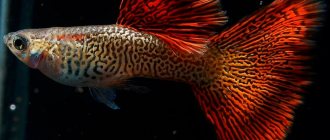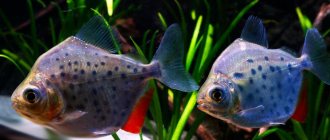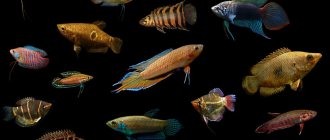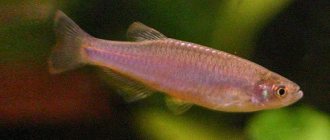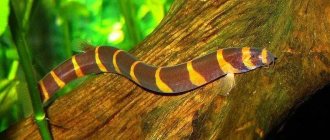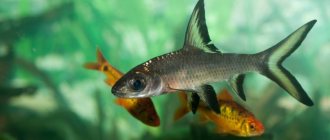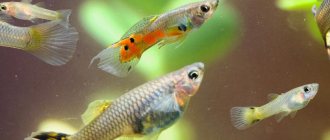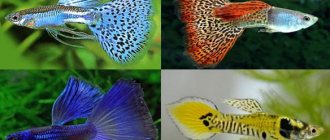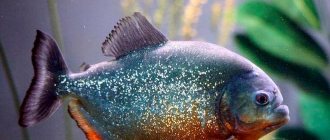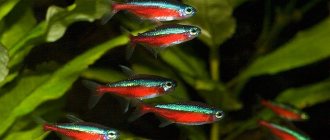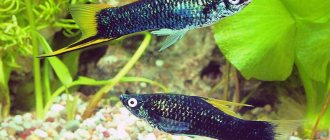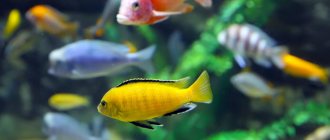Guppies are the most unpretentious species of viviparous aquarium fish and at the same time the most interesting aquarium resident. These fish are very easy to keep and breed.
The homeland of the guppy fish is the rivers of northern South America. Now guppies are acclimatized and settled in warm water bodies on all continents. This is done to control the larvae of malaria mosquitoes. And wild forms of this fish can be seen even in the Moscow River, in the area where warm waters are discharged.
Guppy is a small fish. Females are usually about 5 cm, and males in aquariums do not exceed 2-2.5 cm. Females are gray, inconspicuous with a dark spot near the caudal fin. Some may have black or yellow spots on their fins. But the male guppy is a beautiful fish. The male's small, narrow body is covered with multi-colored spots. Colored strokes and dots form a beautiful pattern. The tail fin is also beautifully colored. All this still shimmers and shines. The shapes of guppies' fins are very diverse. The dorsal fin can be round, triangular, square, or elongated into a ribbon shape. The tail is in the shape of a shovel, ribbon, veil, fan, skirt.
Living in the wild
Guppies are one of the most famous and popular species in the aquarium hobby, as they can be found in every second artificial reservoir. The breed received its name in honor of Robert Guppy, the man thanks to whom the world learned about these colorful fish in 1866.
The natural habitat area is quite extensive - fish can be found on the island. Trinidad and Tobago, in parts of South America. The fish prefer to live in clean fresh water, but are able to survive in brackish liquids. They have a good appetite: in the wild, fish eat worms, larvae, bloodworms and small insects, so a novice aquarist will not have any problems with how to feed guppies in an aquarium. Males in their natural habitat sport brighter colors than females, but are still inferior in brightness to the selected forms.
Interesting fact: guppies were the first fish to visit space. The fish set off to explore the vastness of the Universe together with the team of the Salyut-5 station.
Homeland of the fish
The homeland of the guppy fish is the northern part of South America. But in order not to sound so abstract, they often say more specifically that their homeland is the islands of Barbados and Trinidad, which are located near the South American continent.
But the fish began to be bred en masse in areas where malarial mosquitoes were found (the fish eat their larvae), as a result of which the fish spread and the title of one of the most popular was assigned to them, so the guppy’s homeland is remembered only for history.
Description
Guppies are harmoniously built and miniature fish. On average, the length of male specimens does not exceed 5 cm, but smaller specimens are also found. Since guppies are most often purchased by newcomers to the world of aquarium keeping, new owners often wonder how long guppies live in an aquarium. If the conditions of detention meet the needs of pets, the diet is represented by high-quality products, and care is regular, then the life expectancy of guppies in an aquarium is 2-4 years. Such a short period is due to high temperatures - living in warm water, the metabolic processes of fish are accelerated. This negatively affects how long guppies live.
It is quite difficult to describe the appearance of these popular fish - in the aquarium hobby there are many breeding forms, each of which is unique and beautiful.
Interesting fact: one of the fish’s nicknames is “Millions Fish,” which means “fish of millions.”
Diseases
Guppy diseases can be caused by poor care and infection from contaminated food, plants or other fish. The most common ailments in guppies are problems with their fins:
- Fin compression. Appears due to monotonous and poor nutrition during growing up. Treat with salt baths (1 g of salt per 1 liter of water).
- Fin separation. Most often, the caudal fin splits into several parts. Occurs due to fighting or lack of vitamin D. To treat, add 0.1 ml of iodine to the aquarium for every liter of water.
- Fin rot. Appears due to improper maintenance and infection. Ulcers form on the edges of the fins, which quickly grow over the entire surface. During the process of rotting, the fins disintegrate. Treatment should be with 20-minute salt baths (3 teaspoons of salt per 5 liters of water) and streptocide solution (1.5 mg of medication per 10 liters of water). Also be sure to disinfect the aquarium and rinse the plants and soil. Treatment is continued until the disease subsides.
- Red scab. A scarlet coating appears on the edges of the fins. The disease is caused by the parasite Tetrahymena. Remove infected guppies from the general population. To cure the fish, use a blade to remove the affected areas of the fins and use a solution of chloramphenicol (1 tablet per 20 liters of water). Salt baths also help well. Continue treatment until the fish is completely cured.
Guppies are an excellent choice for beginner aquarists; they are unpretentious, easy to breed and delight with their activity and cheerfulness. Experienced lovers of aquarium inhabitants will enjoy representatives of rare selected species and colors of guppies. They are more demanding to care for, but also incomparably more beautiful.
Kinds
Thanks to their easy maintenance and care, guppies have earned the recognition and love of fans of the underwater world, which forced breeders to work hard on breeding different forms and species. Fish are divided into breeds and varieties based on the type of tail and fins:
- Flagtails
- Veiled tails
- Speartails
- Fantails
- Acute-angled
- Double sword, etc.
How to determine gender by the structure of the fins?
Another difference between male and female guppies is the structure and shape of their fins. The most noticeable difference is in the structure and shape of the caudal fin. Traditionally, in females it has a simple and round shape. Relative to the body, the fins of females are always proportionally smaller than those of males.
The fins of boy guppies are elongated and elongated. The shape of the caudal fin depends on the breed of fish.
In accordance with this characteristic, it is customary to distinguish between fan-tails, lyre-tails, veil-tails, round-tails, needle-tails, spear-tails, and flag-tails. The anal fin (gonopodium) in males has a phallic shape.
Content
Having decided to acquire bright miniature fish, you should take a responsible approach to organizing the living conditions and find out what to feed the guppies and with whom you can keep the guppies in the aquarium. The first thing you need to purchase is a spacious tank. Guppies are schooling fish, and they feel comfortable and cozy only in the company of their relatives, which must be taken into account when choosing a container. On average, one individual should have 3 liters of water, but it is important to remember that part of the volume will be “eaten up” by decor, equipment and plants. Given their small size, it is possible to keep fish in a small tank, but the owner risks the health and life of the pet.
Water quality requirements
The tropics are the natural habitat for these fish, so appropriate conditions must be maintained in the aquarium. The optimal temperature is 24-26 degrees, but guppies are fish that can adapt to new conditions, so they normally tolerate fluctuations within 19-30 degrees.
Indicators of water hardness and acidity are not decisive, because guppies can adapt to these conditions. Therefore, if the changes were not very drastic, then there will be no problems. But there is something that you should not forget to do - change the water in the aquarium every week (about 1/3 of the total volume).
The water itself must be clean and oxygenated. Accordingly, you need to take care in advance about purchasing a reliable filtration system. But keep in mind that the flow of the filter should not be very intense: it will be simply difficult for small individuals to withstand strong water pressure.
Feeding
Feeding should be given special attention, since the life and health of pets depends on it. Beginning aquarists are often lost, not knowing what and how often to feed guppies at home. The first thing the owner of these beautiful creatures needs to know is that fish are omnivores and will happily eat everything that is offered to them. However, this does not mean that you can feed the fish with anything - pets require a correct and balanced diet, the basis of which is considered to be live food: daphnia, coretra, bloodworms, tubifex, brine shrimp. Sometimes you can feed your guppies with finely chopped squid fillets. The menu will be complemented by low-fat cottage cheese, omelette, and bread crumbs, which need to be chopped before serving.
The second part of the diet should be plant foods: seaweed, spinach, lettuce and nettle. The greens are first scalded and chopped. It is important to note that plant foods are intended for adult fish only.
Compatibility
When choosing neighbors for miniature and colorful pets, you should first find out about the compatibility of aquarium guppies with other fish. Improperly introducing guppies into a community aquarium can lead to disastrous results, since these fish cannot fend for themselves due to their peaceful nature. Therefore, before purchasing, you need to study information about with whom guppies get along in the same aquarium.
Representatives of the Poeciliidae family, zebrafish, cockerels, botia, and iris are considered a good choice. It will also be successful to place guppies and neons, guppies and catfish in one tank. Given the peaceful nature of the fish, any peaceful phenotypes of similar size will be suitable as neighbors.
Which aquarium is better to choose?
After purchasing guppies, they need to be given time to adapt so that they get used to their new conditions - temperature and water quality. If this is not done, then there is a high probability that they will simply die.
In most cases, two or three liters of water are enough for one fish (accordingly, for 6 individuals, the volume of the aquarium should exceed 20 liters). The aquarium should be well lit for 10-12 hours a day. Lack of light can cause the fish to become sick, which can also lead to death.
It is better to choose vegetation with soft leaves (hornwort is well suited for these purposes). You can plant Riccia on the surface of the water, in the thickets of which it will be convenient for the fry to hide. Indian fern can be used as a natural biofilter.
Reproduction
Experienced aquarists know firsthand that pleasure comes not only from keeping fish, but also from breeding, but before that you should learn about how to properly raise offspring. Knowing how guppies give birth and how long guppies grow, you can properly organize the conditions for spawning and get healthy and beautiful fish.
Usually, owners do not have problems with breeding pets - guppies readily breed even in a community aquarium. You should not expect offspring immediately after purchase - the fish must get used to the new place. The phenotype refers to viviparous species - that is, the female bears offspring and gives birth to already formed fish. Stimulation of spawning consists of increased feeding with live food and clean water.
Guppy pregnancy lasts about 40 days, then guppy fry are born, which first hide in shelters, and after 2-3 hours begin to swim. Females are capable of reproducing every 4 weeks, but the timing may change depending on the conditions of detention. Beginning aquarists are also concerned with the question of how many fry a guppy gives birth to - with decent care and maintenance, a female can produce 100-200 pieces.
To breed fish, the owner only needs to acquire pets of different sexes and organize good care. Considering that the phenotype is inclined to eat its offspring, the pregnant female should be placed in a separate container before giving birth - a spawning tank. After the birth is completed, the mother is returned to the old aquarium, and the owner will have to feed the babies. Baby guppies are excellent eaters of crushed flakes, specialized food, brine shrimp nauplii, and chopped tubifex. Babies need to be fed 2-3 times a day.
In order for the offspring to grow healthy and beautiful, it is necessary to carefully care for the young individuals:
- Remove food debris and dirt.
- Plant living vegetation in the spawning area.
- Plant an ampoule or coils into the artificial pond, which will help in cleaning the container.
- Renew water - 25% of the volume weekly.
- Maintain temperature regime – 24-26.5C.
- After 4-6 weeks, the gray and inconspicuous fish will begin to acquire bright colors, and the fry can be transplanted into the tank with adult pets. The phenotype reaches sexual maturity at 2-3 months.
It is important to note that when breeding, you cannot keep different breeds and species in the same reservoir. Also, when crossing, it is advisable to bring together fish of the same color.
An interesting fact: to give birth to offspring, a female needs a container equal in volume to a glass of water.
Guppies are the most famous and popular aquarium inhabitants, which have proven themselves to be hardy, tenacious and attractive fish. The main advantage of the phenotype is the variety of shapes and colors - every aquarist will be able to choose a variety to his liking. In addition, these fish are easy to care for, and it is interesting to watch in the aquarium: how the fish sleep, play happily and play mating games.
Guppy fry
When the fry are born, it is better to remove the female, because some females eat the fry. After the guppy gives birth, her tummy will gradually decrease. The fry are also omnivores, the main thing is that the food is the right size for them.
It takes quite a long time for the fry to reach the size of an adult—at least 3 months. The rate of their growth is affected by the water temperature - the higher it is, the faster the fry develop. However, there is an important feature associated with the development of male guppies - the longer their “childhood”, the larger size they will eventually reach. At a water temperature of 30 °C, they fully ripen in 3 months, but subsequently remain small.
